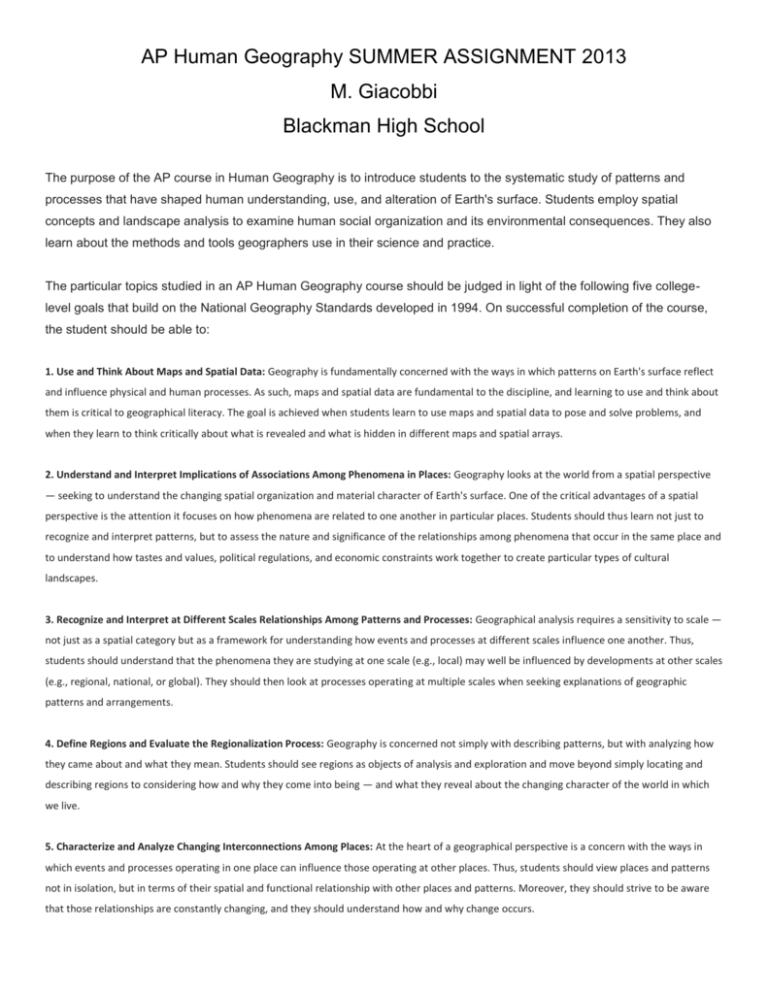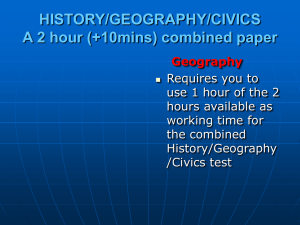AP Human Geography SUMMER ASSIGNMENT 2013
advertisement

AP Human Geography SUMMER ASSIGNMENT 2013 M. Giacobbi Blackman High School The purpose of the AP course in Human Geography is to introduce students to the systematic study of patterns and processes that have shaped human understanding, use, and alteration of Earth's surface. Students employ spatial concepts and landscape analysis to examine human social organization and its environmental consequences. They also learn about the methods and tools geographers use in their science and practice. The particular topics studied in an AP Human Geography course should be judged in light of the following five collegelevel goals that build on the National Geography Standards developed in 1994. On successful completion of the course, the student should be able to: 1. Use and Think About Maps and Spatial Data: Geography is fundamentally concerned with the ways in which patterns on Earth's surface reflect and influence physical and human processes. As such, maps and spatial data are fundamental to the discipline, and learning to use and think about them is critical to geographical literacy. The goal is achieved when students learn to use maps and spatial data to pose and solve problems, and when they learn to think critically about what is revealed and what is hidden in different maps and spatial arrays. 2. Understand and Interpret Implications of Associations Among Phenomena in Places: Geography looks at the world from a spatial perspective — seeking to understand the changing spatial organization and material character of Earth's surface. One of the critical advantages of a spatial perspective is the attention it focuses on how phenomena are related to one another in particular places. Students should thus learn not just to recognize and interpret patterns, but to assess the nature and significance of the relationships among phenomena that occur in the same place and to understand how tastes and values, political regulations, and economic constraints work together to create particular types of cultural landscapes. 3. Recognize and Interpret at Different Scales Relationships Among Patterns and Processes: Geographical analysis requires a sensitivity to scale — not just as a spatial category but as a framework for understanding how events and processes at different scales influence one another. Thus, students should understand that the phenomena they are studying at one scale (e.g., local) may well be influenced by developments at other scales (e.g., regional, national, or global). They should then look at processes operating at multiple scales when seeking explanations of geographic patterns and arrangements. 4. Define Regions and Evaluate the Regionalization Process: Geography is concerned not simply with describing patterns, but with analyzing how they came about and what they mean. Students should see regions as objects of analysis and exploration and move beyond simply locating and describing regions to considering how and why they come into being — and what they reveal about the changing character of the world in which we live. 5. Characterize and Analyze Changing Interconnections Among Places: At the heart of a geographical perspective is a concern with the ways in which events and processes operating in one place can influence those operating at other places. Thus, students should view places and patterns not in isolation, but in terms of their spatial and functional relationship with other places and patterns. Moreover, they should strive to be aware that those relationships are constantly changing, and they should understand how and why change occurs. Assignment: The reading of current books about culture, economics, politics, etc. is required for this class and students will receive a test grade for it. The list below is your suggestions, but other books may be accepted if pre-approved. E-mail me for a different choice, if you have one that relates to this class. (♣) Contain language or depictions which may be considered offensive by some. Confucius Lives Next Door (T.R. Reid) The United States of Europe (T.R. Reid) Fast Food Nation (Eric Schlosser) Savages and Civilization (Jack Weatherford) Ten Geographic Ideas That Changed the World (Susan Hanson) Guns, Germs, and Steel (Jared Diamond) Collapse (Jared Diamond) The World is Flat (Thomas Friedman) Nickel and Dimed ♣ (Barbara Ehrenreich) Freakonomics ♣(Steven D. Levitt) These books can be found in most libraries. 1. Read the book first, than if possible find the companion movie for it has one, but it is not necessary to complete the assignment (You tube has some). 2. You are to write an analysis of the text in the following format. This is a college level class, so writing is a large portion of the assignments Introduction (Title Page) Here you want to provide basic information about the book, and a sense of what your report will be about. You should include: 1. 2. 3. 4. Title (underlined)/Author Publication Information: Publisher, year, number of pages Genre A brief (1-2 sentences) introduction to the book and the report/review. Body There are two main sections for this part. The first is an explanation of what the book is about. The second is your opinions about the book and how it relates to the course of Human Geography. A good place to start is to explain the author's purpose and/or the main themes of the book. Then you can summarize. Provide a general overview of the author's topic, main points, and argument. What is the thesis? What are the important conclusions? Don't try to summarize each chapter or every angle. Choose the ones that are most significant and interesting to you. At least 5 chapters must be summarized Analysis and Evaluation In this section you analyze or critique the book. You can write about your own opinions; just be sure that you explain and support them with examples. Some questions you might want to consider: Did the author achieve their purpose? Is the writing effective? What are the strengths and weaknesses of the author’s theories? What are the author's qualifications to write about the subject? Do you agree with the author's arguments and conclusions? What is your overall response to the book? Did you find it interesting, moving, dull? Would you recommend it to others? Why or why not? How does the book analyze one of the themes of Human geography Conclusion Briefly conclude by pulling your thoughts together. You may want to say what impression the book left you with, or emphasize what you want your reader to know about it. Requirements: Typed, 12 point, double spaced, 1 inch margins, title page, and at least 3 pages of the body, analysis, evaluation and conclusion. Due first full day of class August 12th, 2013











